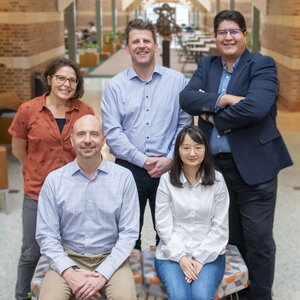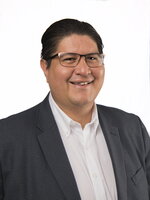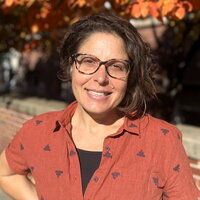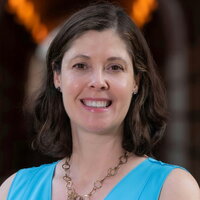By Jenna Kurtzweil, The Beckman Institute
Good things come in microscopic packages, according to the Beckman Institute for Advanced Science and Technology’s new DROPLETS project.
By packaging electrochemical reactions in smaller-than-standard serving sizes, interdisciplinary researchers aim to produce clean hydrogen, sequester carbon dioxide, and store renewable energies like wind and solar inexpensively and sustainably. Their project, called DROPLETS, received $4.5 million from the U.S. Department of Energy’s Office of Science through its Energy Earthshots Initiative.
“If we do this right, we will lay out a foundation for our clean energy future,” said project lead Joaquín Rodríguez-López, a professor of chemistry at the University of Illinois Urbana-Champaign and a researcher at the Beckman Institute for Advanced Science and Technology. “And the foundation for that clean energy future is electrochemistry.”
Captivated by the synergy between chemistry and electricity, Rodríguez-López has already used electrochemistry to capture carbon dioxide in the atmosphere, recycle plastics, and design batteries to store renewable energy.
Now, he's siccing his electrified science on the Energy Earthshots Initiative, a U.S. Department of Energy program created to quash net carbon emissions by 2050 and make renewable energy usable and accessible for more Americans in the next decade. The initiative supports projects that address specific clean energy challenge areas called Earthshots. In late September, the DOE announced its dispersal of $264 million across 29 projects: 18 university-based teams like Rodríguez-López’s received a total of $69.1 million through the Funding Opportunity Announcement for Science Foundations for Energy Earthshots, and 11 Energy Earthshot Research Centers led by national labs received a collective $195 million.
“The Energy Earthshot Research Centers and the related work happening on college campuses around the country will be instrumental in developing the clean energy and decarbonization solutions we need to establish a 100% clean grid and beat climate change,” said U.S. Secretary of Energy Jennifer M. Granholm in a DOE press release.
Rodríguez-López’s proposal, which secured $4.5 million, intersects three Earthshots focused on broadening the clean hydrogen market (Hydrogen Shot); enabling low-cost, long-term energy storage (Long-Duration Storage Shot); and supporting efforts to capture carbon dioxide by the gigaton, a unit equivalent to 182 million American homes’ annual electricity use (Carbon Negative Shot).
The latter is particularly thorny because of its invisibility, according to Rodríguez-López — our eyes don’t register carbon dioxide accumulation as readily as smoggy clouds circling a cityscape or smokestacks billowing from an old-growth forest.
“But it’s there,” he said. “And it’s a problem.”
Rodríguez-López’s proposed solution is similarly invisible to the naked eye.
The project reimagines the electrochemical reactions used to advance clean energy (for example, splitting water to generate hydrogen). Typically, such reactions simmer away in a single beaker and are beholden to an electrochemical reactor and its cornucopia of awkward hardware.
“You have cables, electrodes, the reactor itself — the entire system can take up physical space and can be financially limiting as well. There are many situations where an electrochemical reactor can be limiting. I want to push past those limits to take electrochemistry outside of the reactor,” Rodríguez-López said.
For Rodríguez-López, thinking outside the reactor means decentralizing the reaction.
His riff on the classic single-beaker setup involves running multiple reactions simultaneously in microscopic, water-based droplets — like scattered bistro furniture as an artful alternative to a single dining table.
“Microdroplets are exactly what you’d imagine,” Rodríguez-López said, “Very, very small droplets of solution that you need a microscope to see.”
While squinting is required to see them in action, microdroplets make up for their diminutive stature with lightness of foot. Like swapping a seven-layer cake for a sheet of cupcakes in the oven, microdroplet-based reactions have been observed to cook (or catalyze) faster than they would in bulk.
But unlike baked goods, a microdroplet's chemical composition is not an exact mimic of its larger counterpart. Therein lies its (literal) power: the researchers hypothesize that the droplets’ microscopic size will distinctly alter the physical and chemical properties of the electrochemical reactions taking place inside.
Each property — portability, affordability, speed, electrification — equips microdroplets to host chemical reactions that can help generate clean hydrogen, store energy, and trap carbon dioxide — an electrified arrow through all three of the project's target Energy Earthshots.
Achieving multiple Energy Earthshots was important to the research team, which consists of a dozen researchers across three UIUC departments and five total institutions.
“It’s not only the number of minds, but the expertise that they bring,” Rodríguez-López said. “Clean energy research does not exist in a vacuum, and I wanted the interdisciplinary component to be there in the DNA of the group from the very start — because interdisciplinary approaches lead to diverse applications.”
Indeed, practical applications of DROPLETS are varied. Clean hydrogen, for example, may be used to create fuel cells, which power cars and buses (and, according to the DOE, heavy-duty trucks) while producing nothing but heat and water. Electricity-based flow batteries might help to inexpensively store
wind and solar energy beyond the bounds of a single windstorm or sunny Saturday. Carbon capture techniques will not only extract the pollutant from the atmosphere, but “put it to good use” by folding it into carbon-based compounds, Rodríguez-López said.
“It is a risky project, but the payoff will be great,” he said. “We have very smart researchers, and very smart students, and very smart postdocs, and that means we have a shot — an Earthshot.”
A homespun derivative of the term moonshot, the DOE’s flagship phrase encapsulates the spirit of DROPLETS: exploratory, imaginative, rounded in research and anchored in not-too-distant applications.
“Exploring new reactions, creating new pathways,” Rodríguez-López said. “What better project for a chemist?”
___________________________________________________________
Editor's note:
Read the full announcement from the DOE Office of Science: https://content.govdelivery.com/accounts/USDOEOS/bulletins/3734192
Additional investigators affiliated with the Beckman Institute include Qian Chen, the Racheff Faculty Scholar and an associate professor of materials science and engineering; Jeffrey Moore, the Stanley O. Ikenberry Endowed Chair Emeritus of Chemistry and a professor emeritus of chemistry; and Charles Schroeder, the Dr. Ray and Beverly Mentzer Professor and a professor of chemical and biomolecular engineering and the James Economy Professor of materials science and engineering. Additional UIUC investigators include Paul Kenis, a professor of chemical and biomolecular engineering; Christy Landes, the Jerry A. Walker Endowed Chair and a professor of chemistry; Lisa Olshansky, an assistant professor of chemistry; and Hong Yang, the Richard C. Alkire Chair and professor of chemical and biomolecular engineering.
Researchers from the Georgia Institute of Technology, Northern Arizona University, Texas State University, and Argonne National Laboratory also contributed to this project.




